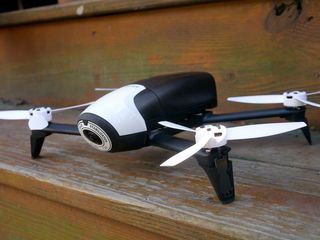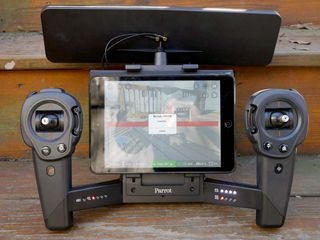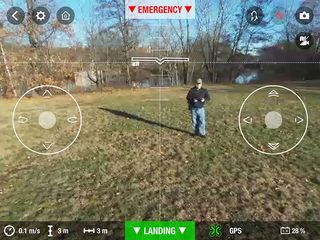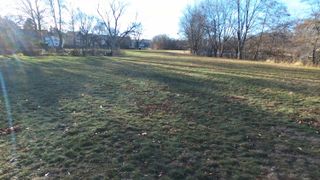Parrot Bebop 2 Drone Review
A simple and fun-to-fly drone that takes great video and stills.
Why you can trust Tom's Guide

Parrot has updated its popular camera drone with the Bebop 2, which promises double the flying time and true autonomous flying. It mostly succeeds: we found that the Bebop 2 is a blast to fly, with nippy performance, excellent battery life and very attractive video. There are still some rough edges, though: the touch-screen controls lack sensitivity, and the fish-eye lens is rather prone to lens flares and similar glitches.
Design
You would be forgiven for mistaking the Bebop 2 for the original Bebop. It features the same shape, plastic frame construction and fisheye lens on the front, except that now only a small amount of fragile and easily scratched foam surrounds the front lens. Parrot also claims to have completely reengineered of the frame and body to make the drone tougher without increasing weight and size (17 ounces, 13 x 12 x 4 inches).
A good chunk of the weight is the battery, a hefty (6.8 ounces) 2700mAh Li-Polymer battery that slide locks into the back of the case. That is more than double the capacity (and weight) of the original Bebop's battery. Parrot also includes a couple of velcro strips that loop around it for extra security.

The fisheye lens, with its 170-degree view, sits on the front. This means that the Bebop 2 can see almost everything in front of it; far left, right, above and below. It doesn’t record all of this view: instead, it uses this to stabilize the video by sensing the movement of the quadcopter and moving the area captured as video to respond to that. So, when the quadcopter tilts because it is about to move forward, the computer inside the Bebop 2 responds and moves the video capture area to cancel that movement. Most drones use an active stabilization system, where motors physically move the camera to compensate, but the Bebop 2 does all this in software, using the fisheye lens as a digital stabilization system. It sounds more complex (and it is), but it is quite effective: in most situations, the video is smooth and sharp, with gentle pans and turns that belie the more aggressive turns that the quadcopter is making. It also means that you can pan and tilt the recorded video view without moving the quadcopter itself.
In addition to this digital stabilization, the camera and other electronics are in a part of the body that is physically separate from the base. These two parts are connected with soft rubber spheres, which absorb the vibrations from the motors. Again, this system is quite effective.
Specs
Rotors: 4 (3 blades per rotor); replaceable, 5-inch diameter
Battery Size: 2,700-mAh Li-ion polymer (quadcopter)
Battery Life: 25/22 minutes (claimed/tested)
Flight Time: 23 minutes
Camera: 14 megapixels, 30 fps
Smartphone Controlled: Optional
Size: 13 x 12 x 4 inches
Weight: 17 ounces
Controller
There are two ways to control the Bebop 2: from a smartphone or from the new Skycontroller Black. We tried both. The smartphone control is through the FlightAware 3 app, available for both iOS and Android. This is the same app that used for lower-end drones from Parrot, but don’t be fooled: it is a sophisticated app that offers a lot of features.

From here, you can fly the drone directly, track the GPS location of the quadcopter and smartphone, take photos or videos and access all of the settings. The app is a little confusing at first, throwing a lot of data on the screen at once on top of the live view from the quadcopter. However, it isn’t difficult to figure out once you figure it out, and it provides a simple interface to most of the features of this drone, including takeoff, landing, video start and stop, still images and battery levels.
Screen: FreeFlight
The other way to control the Bebop 2 is with the new Skycontroller black. This is a large, rather heavy device that looks like a prop from a Sci-Fi movie. It dwarfs the controllers of other drones like the Yuneec Q500, with an antenna that is bigger than most of them. It includes two control sticks, a number of buttons and a large antenna on the front that can be moved and tilted to point towards the Bebop 2. You phone or tablet running FightAware 3 fits into the middle of this, locking into place so you can see the live video on the screen. A neck strap is also included, and this is a good thing, as the whole thing with an iPad mini attached weighs in at a cumbersome 4 lbs and 3.3 oz (just over 1.9Kg). You need both hands to hold and use the Skycontroller black, with each hand holding one of the handles. The left hand gets one control stick and buttons to start recording, access settings, go back and a mouse control to navigate the on-screen menu. The right hand gets the other control stick, plus buttons to mark a GPS location, return home and to move the camera view. On the bottom of the device are LED indicators for the battery on the Skycontroller, on the drone and signal strength between the two.
The idea here is that it completely replaces the touch screen control: you should be able to fly and change settings without ever taking your hands off the controllers. It works fairly well once you figure out the button layout: I was able to complete several flights using the Skycontroller and an iPad Mini without touching the iPad screen once the app was running. The control sticks also fall naturally under the thumbs when you grasp the handles, and it is comfortable to use for longer flights once you adjust the weight around your neck. However, the Skycontroller black is large and heavy, which seems to defeat the purpose of the Bebop 2 somewhat. On its own, the Bebop 2 is a very portable drone that you can easily take with you. Add in the Skycontroller black, though, and you have a large, bulky and awkward thing to carry around with you.
The Skycontroller does allow you to use other interesting features, though. Plug a video headset into the HDMI port and you get to see what the quadcopter sees. A USB port also allows you to control the drone from a computer through the ARDRoneSDK that the company offers to programmers.
MORE: Parrot Bebop Drone Review
However you are controlling the Bebop 2, it connects using a 2.4GHz or 5GHz Wi-Fi signal, which is automatically selected to minimize interference. If you are using a tablet and FreeFlight 3, the connection is between the quadcopter and your phone/tablet. If you are using the Skycontroller, there is one Wi-Fi connection between the Bebop and the Skycontroller, and another between Skycontroller and your device. Either way, this means that you have to fiddle with the Wi-Fi settings on your phone/tablet to use, which some users may find confusing. We had no problems maintaining a connection using an iPad alone up to about 100 feet away, although the preview video did get rather glitchy at this distance, making it harder to control The Skycontroller definitely gets the stronger signal, thanks to the huge antenna on the front.
This was able to maintain a strong connection to the quadcopter over much longer distances: we tested it to several hundred feet, and Parrot claims it can manage up to about 3.5 miles (6 kilometers). If you are planning on flying at long distances (or in areas that are crowded with Wi-Fi signals), the Skycontroller would be a useful addition. Casual fliers won’t need it, though.
Flying
Flying through the FreeFlight 3 app is a mixed experience. On the upside, the app lowers the learning curve for new fliers, because it is automated. To take off, you tap the takeoff button, and the quadcopter lifts off and hovers about 5 feet off the floor. To maneuver, you press one of the virtual control sticks on the screen and move your finger. In the default setup, the left stick control altitude and rotation, while the right one controls left-right and front-back movement. There is also a trick mode: select the trick you want from the drop-down menu at the top of the screen and double-tap, and the Bebop 2 does the trick. These tricks include front and back somersaults or a left and right flip. When you are done, tap the landing button and the Bebop 2 gently settles down on the ground. It is very simple and straightforward to learn and use, which will suit nervous or novice fliers.

The downside is that there is a slight (but perceptible) delay between moving the on-screen control and the quadcopter responding, and the controls lack subtlety. The delay is more annoying than problematic, but it would be advisable to avoid obstacles and high-speed flying until you get used to it. The lack of subtlety is also annoying, because it makes it more difficult to do things like make a very slow pass over a scenic location while taking video. There is nothing in between hovering and a moderate speed pass, presumably to smooth out any finger twitches. For most users, though, the ease of use will overweight the disadvantages.
The Skycontroller avoids both of these issues: the control sticks are responsive to even slight movements, and the delay is much less noticeable. That makes it much easier to control the Bebop 2 when flying both fast and slow, either maneuvering when navigating an obstacle or doing a slow pass for a better looking video. Other features are mapped onto buttons on the Skycontroller, with buttons for return home and land, start and stop video and other functions. The Skycontroller certainly feels comfortable in the hands, but I didn’t find it any more comfortable than the much smaller controllers of the Yuneec Q500 or the DJU Phantom 3.
Autonomous Flying
The Bebop 2 doesn’t offer a true autonomous mode out of the box, but you can add this with the $19.99 purchase of the FlightPlan in-app feature. This turns the Bebop 2 into an autonomous drone that can follow a GPS defined flight plan, moving from waypoint to waypoint and doing things like taking photos or video, rotating and tilting to pre-defined angles or pausing.
Flightplans can be saved, named and replayed with a single tap. This certainly adds a new angle to the Bebop 2: you could, for instance, create a very unusual timelapse of a building project from above by creating a flight plan that involves flying to a certain point above the site and taking a photo, then running it once a day. Some caution is required, though: the Bebop 2 will happily fly straight into a tree or other obstacle if you aren’t cautions about the path between the waypoints, and will also fly out of signal range.
While a flight plan is running and you are connected, you can intervene and stop it, but not when it is too far away to control. You also can’t record and play back a flight that you made, even though the FreeFlight app automatically records the details of your flights and stores them online. This seems like an odd omission: often the best way to create a safe flight path is to fly it manually, record it and then play it back, and similar apps for drones like the Yuneec Q500 and DJI Phantom 3 allow this.
Photos And Video
We were impressed with the quality of the video from the Bebop, and the Bebop 2 continues this trend. Video is captured at Full HD (1920 by 1080 pixel) resolution at 30 frames per second and has good color and smooth movement. There is some fairly obvious processing from the digital stabilization that the Bebop does, though: straight lines and edges have a rather abrupt stair-step look to them, especially high-contrast ones. Apart from this, the digital stabilization works extremely well: the pans and tilts that the quadcopter makes are mostly not visible in the final video, which has a very smooth and natural look to it. This is even the case in situations such as the Bebop 2 being buffeted by the wind: the video still looks like it was shot from a steady platform. The camera built into the Bebop 2 can also capture 14-megapixel still images, either using the same stabilization as video, or without this as fish-eye images that capture a 170 degree field of view.

This wide-angle lens does have a cost, though: it is rather prone to picking up lens flares that can make your video look like a JJ Abrams film and detract from the overall quality. Lens flares are caused when light enters the lens at an angle and reflects off the elements of the lens, and fish-eye lenses are very prone to this, because the wide view of the lens means that the lens is often at an angle to catch the light.
The video that the Bebop 2 captures doesn’t have the sharpness and clarity that made the DJI Phantom 3 out top pick for video drone, though. Although it is smooth and has decent detail, it lacks the punch and depth of color that the Phantom had, and the stairpatepping from the digital stabilization is very disconcerting when you notice it.
MORE: Best Drones of 2015
Photos and videos are captured on the 8GB of flash memory built into the device, then transferred wirelessly to the FreeFlight app, or through a USB cable that plugs into the back of the Bebop 2. 8GB is enough to hold about 50 minutes of video, so even the most ardent aerial videographers shouldn’t run out of space. Videos are stored as MP4 files, which can be imported into most video editing apps, such as iMovie.
Repairability
The Bebop was a very easy to repair drone, and the Bebop 2 continues this: any part of the drone can be easily swapped out and replaced. The rotor blades are easy to remove with the included tool, and a replacement set of 4 costs $13. The feet of the drone can also be swapped out and replaced if they get broken, with a new set costing $13.
Battery Life
The battery is one of the main updates from the Bebop. While the original model had a 1200 mAh battery that provided a flight time of about 9 minutes, the Bebop 2 has a bigger 2700 mAh battery that lasts a claimed 25 minutes of flight. We found that this claim was pretty much spot-on: we were able to get about 23 minutes of flight time out of the included battery, which is a huge improvement over the 10 minutes we got from the original Bebop. This means longer shots, and more time to think about and frame the shot you want without worrying about the battery.
The same battery is used in the Skycontroller Black, and a spare battery will cost you $55. That’s not cheap, but the extra flight time the bigger battery gives makes it easier to bear.
However, owners of the original Bebop are out of luck: the batteries that came with this are not compatible with the Bebop 2, as they new batteries are larger, heavier and have a different connector. These new batteries also take a long time to recharge: each battery took about 70 minutes to recharge with the included charger, which can only recharge one battery at a time.
Bottom Line
The kit we tested isn’t cheap: Parrot sent us the Bebop 2, the Skycontroller and a Parrot-branded backpack that neatly holds everything, a combination that retails for a heady $800. You’ll pay about $550 for the Bebop 2 without the extras. That’s a lot when you can pick up a video recording drone like the UDI U8171A for less than $50, but the Bebop 2 captures much better photos and video, is easier for novices to fly and has some serious performance chops.
There is an awful lot to like in the Parrot Bebop 2. It is a simple, fun to fly drone that takes great quality video without much fuss. It automates the tricky parts of flying (takeoff and landing) and handles breezes without a problem. The longer battery life also makes it more enjoyable, providing time to get comfortable with the controls and take video and photos without worry. The touch-screen controls are a little quirky, though, and the optional SkyController Black is very large and bulky: while you could throw the Bebop 2 itself into a backpack to take video on a day hike and leave room for lunch, the SkyController would take up most of the backpack alone. This aside, the Bebop 2 is a great update to the Bebop and remains the go-to drone for those who want simple flying and great-looking video.
Sign up to get the BEST of Tom’s Guide direct to your inbox.
Upgrade your life with a daily dose of the biggest tech news, lifestyle hacks and our curated analysis. Be the first to know about cutting-edge gadgets and the hottest deals.
Richard Baguley has been working as a technology writer and journalist since 1993. As well as contributing to Tom's Guide, he writes for Cnet, T3, Wired and many other publications.
